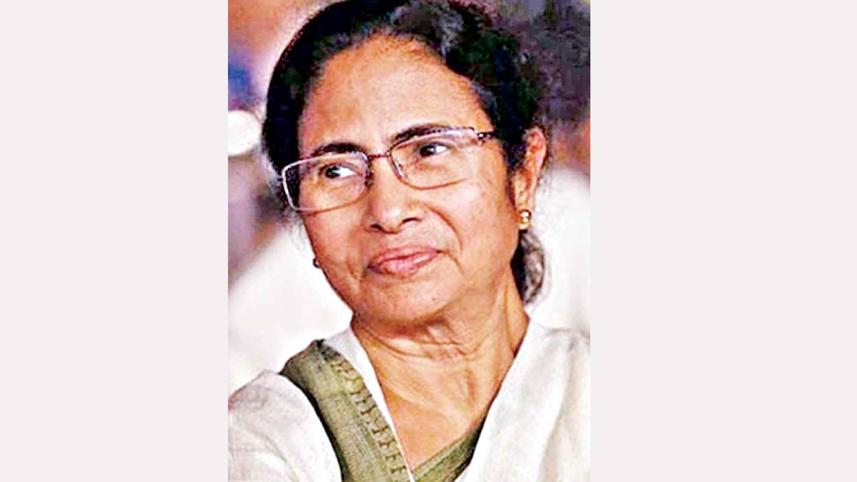Mamata takes centre stage

It may be too early to tell, but the signs seem promising for Trinamool Congress chief Mamata Banerjee.
TMC's landslide victory in the West Bengal assembly elections over the Bharatiya Janata Party, helmed by Narendra Modi and Amit Shah, is propelling Mamata to becoming the focal point of opposition parties' united effort to halt the BJP in the 2024 general elections.
An array of senior Congress leaders, who had shot off a letter to party President Sonia Gandhi last year seeking organisational changes after its abject defeat in the 2019 parliamentary polls, have been gushing over Mamata's leadership since the Bengal poll results came out on May 2.
Among those leaders are Ghulam Nabi Azad who termed Mamata as the "Lioness of the East" for fighting and winning against all odds. In a tweet, Kapil Sibal described her as a courageous grassroots leader and a modern "Jhansi ki Rani" who proved that no matter the odds, "Goliaths can be humbled".
Another senior Congress leader Manish Tewari also called Mamata the "Rani of Jhansi who has rewritten history", and Anand Sharma said her win "has given a ray of hope to all those who believe in an inclusive and democratic India".
Perhaps the most ringing endorsement came from veteran Congress leader Kamal Nath, former chief minister of Madhya Pradesh, who said Mamata was "the leader of India".
Even amid the fulsome praise for Mamata, who broke away from Congress in 1987, all the aforementioned Congress leaders avoided going into the issue of putting up a common face of the opposition to take on Modi in the next general elections.
Kamal Nath, who had led his party to victory in the heartland state in the 2018 assembly polls there against the BJP, had to step down as chief minister of Madhya Pradesh when a majority of Congressmen defected to the BJP in 2020, bringing the saffron party back to power there.
Asked if Mamata, the leader of TMC, could be the face of the opposition in the 2024 electoral battle, Nath stated the obvious on Wednesday: it is for the United Progressive Alliance (UPA) led by Congress to decide.
TMC and its electoral symbol of the "Jora Ghas Phul" is not part of the UPA, which ruled India from 2004 to 2014 under Manmohan Singh's prime ministership and Sonia's chairmanship of the alliance before it was voted out by the BJP-led National Democratic Alliance (NDA).
But that the senior Congress leaders are publicly lavishing praise on Mamata's leadership is itself significant – political observers see it as a curt message to the Gandhi family (Sonia, Rahul and Priyanka) to go for the much-needed organisational changes.
What appears to have strengthened Mamata's claim to be the opposition's face is no doubt TMC's unexpectedly momentous win in Bengal. But there are still hurdles she has to negotiate and many questions and considerations with which the opposition has to contend.
First: is an anti-BJP front possible without Congress and is it fair to write the political obituary of the grand old party just because it has lost in the recent round of assembly elections in Kerala, Assam and was wiped out in Bengal?
Many political pundits tend to write off Congress every time it loses general elections or state-level polls. The same pundits then hail the party's resilience when it overcomes setbacks and returns to winning ways like the party had done in the assembly elections in Rajasthan, Madhya Pradesh and Chhattisgarh in 2018.
One must not forget that Congress is still the party with the highest number of Lok Sabha seats (51) after BJP -- more than any regional party.
Secondly, Congress continues to retain its pan-India footprints and is in power in three states -- Rajasthan, Chhattisgarh and Punjab which together account for a total of 49 Lok Sabha seats. By contrast, no regional party has appeal beyond the border of a state. Congress too had won against the might of the BJP in Rajasthan, Madhya Pradesh and Chhattisgarh assembly elections in 2018.
Thirdly, regional parties are more concerned with protecting their respective state turfs where they are in competition with either BJP or Congress and, unlike Congress, lack a pan-India agenda or vision. Only Tamil Nadu witnesses a direct fight between two regional parties -- Dravida Munnetra Kazagham and its principal rival All India Anna Dravida Munnetra Kazagham.
Fourthly, observers think Mamata is not the only powerful regional leader to set up a national network of regional parties. Sharad Pawar, the head of Nationalist Congress Party, is also regarded as an influential prime mover of opposition unity.
Pawar's party, also an offshoot of Congress, is a key constituent of the ruling coalition in Maharashtra with the second highest number of Lok Sabha seats (48) after Uttar Pradesh (80).
Without Congress in it, the framework of a joint anti-BJP opposition has to be essentially a sum total of regional parties and states as an alternative to the Modi-led BJP. Can these parties with state-specific agendas have a common national programme and agree on a common prime ministerial candidate? How durable will such an arrangement be and how appealing will it be to voters who often vote differently in state assembly and national elections?
One saw how in 2015 an opposition alliance led by Nitish Kumar crumbled in Bihar and how Mamata herself had unsuccessfully tried to put together an anti-BJP front through a series of meetings in 2018 in the run up to the 2019 general elections.
The history of regional party leaders or breakaway Congress leaders becoming PMs like Charan Singh, H D Deve Gowda, Morarji Desai, V P Singh, Chandrashekhar and Inder Kumar Gujral does not inspire confidence about the stability of governments under them.




 For all latest news, follow The Daily Star's Google News channel.
For all latest news, follow The Daily Star's Google News channel.
Comments